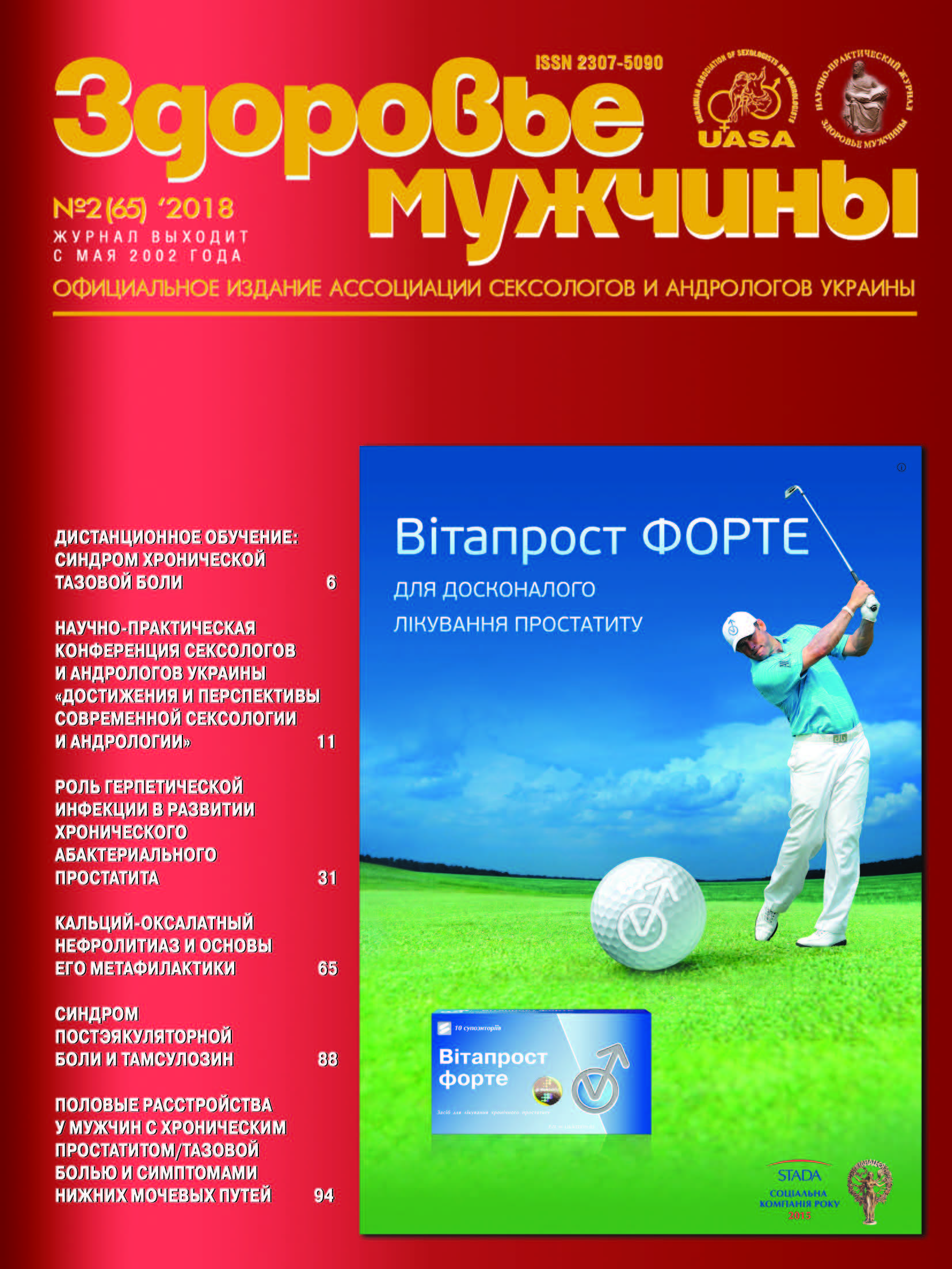Pathomorphological features of the inflammatory process of the tissues of the prostate cancer and benign prostatic hyperplasia in patients, depending on the infectious agents of sexually transmitted diseases
##plugins.themes.bootstrap3.article.main##
Abstract
The objective: the detection of pathomorphological features of the inflammatory process in the intraoperatively removed prostate tissue of the prostate cancer patients (RPZ) and benign prostatic hyperplasia (BPH) depending on the infectious agents of sexually transmitted diseases.
Materials and methods. 317 patients aged 42 to 83 years (mean 62 years) were examined, of which 122 patients with RPD had undergone radical prostatectomy and 195 patients with BPH - prostatectomy.
Results. The obtained results suggest that the pronounced degree of inflammatory process occurs only in patients with prostate cancer infected with sexually transmitted diseases pathogens, whereas in noninfected, predominant light stomach or a lack of inflammation and pronounced degree is not determined at below. Patients with prostate cancer are more likely to have symptoms of severe inflammation, areas of the tumor beyond the tumor and poorly differentiated tumors.
Conclusion. The established facts require further in-depth study of this problem in order to better understand the etiopathogenesis and improve treatment and prophylaxis of prostate tumors.
##plugins.themes.bootstrap3.article.details##

This work is licensed under a Creative Commons Attribution 4.0 International License.
Authors retain the copyright and grant the journal the first publication of original scientific articles under the Creative Commons Attribution 4.0 International License, which allows others to distribute work with acknowledgment of authorship and first publication in this journal.
References
Hsing A.W., Chokkalingam A.P. Prostate cancer epidemiology // Front Biosci. – 2006. – Vol. 11. – P. 1388–1413. http://dx.doi.org/10.2741/1891
Ries L.A.G., Melbert D., Krapcho M., Mariotto A., Miller B.A., Feuer E.J., Clegg L., Horner M.J., Howlader N., Eisner M.P., Reichman M., Edwards B.K. (Eds). Cancer Statistics Review, 1975–2004. National Cancer Institute, Bethesda, MD, 2007. https://seer.cancer.gov/archive/csr/1975_2004/
Taylor M. Prostate cancer and sexually transmitted diseases: a meta-analysis / M. Taylor, A. Mainous, B. Wells. – Fam Med, 2005. – 37 (7):506–12. PDF
Platz E.A., De Marzo A.M. Epidemiology of inflammation and prostate cancer // J. Urol. – 2004. – Vol. 171, № 2. – P. 36–40. https://doi.org/10.1097/01.ju.0000108131.43160.77
Imyationov E.N., Togo A.V., Hanson K.P. Searching for cancer-associated gene polymorphisms: promises and obstacles // Cancer Lett. – 2004. – Vol. 204. – P. 3–14. https://doi.org/10.1016/j.canlet.2003.09.026
Palapattu G., Sutchiffe S., Bastian P. et al. Prostate carcinogenesis and inflammation: emerging insights // Cancerogenesis. – 2005. – Vol. 26. – P. 1170–1181. https://doi.org/10.1093/carcin/bgh317
Lucia M.S., Epstein J.I., Goodman P.J. et al. Finasteride and high-grade prostate cancer in the Prostate Cancer Prevention Trial // J. Natl. Cancer Inst., 2007. – Vol. 99. – P. 1375–1383 https://doi.org/10.1093/jnci/djm117
Thompson I.M., Tangen C.M., Goodman P.J. et al. Long-Term Survival of Participants in the Prostate Cancer Prevention Trial. // N. Engl. J. Med., – 2013. – Vol. 369. – P. 603–610. https://doi.org/10.1056/NEJMoa1215932
Dennis L.K., Dawson D.V. Meta-analisys of measures of sexual activity and prostate cancer // Epidemiology. – 2002. – Vol. 13(1). – P. 72–79. https://doi.org/10.1097/00001648-200201000-00012
Algaba F., Mikuz G., Betran A. et al. Prostate carcinoma: atrophy or not atrophy, that is the question // European urology. – 2007. – Vol. 52. – P. 1293–1296. https://doi.org/10.1016/j.eururo.2007.07.039
Переверзев А.С. Воспаление и рак простаты // Урология. – 2011. – № 4 (59). – С. 59–69.
Vasto S., Carruba G., Candore G. et al. Inflammation and prostate cancer // Future Oncol. – 2008. – Vol. 4 (5). – P. 37–45. https://doi.org/10.2217/14796694.4.5.637
Roberts R., Bergstrlh E., Bass S. et al. Prostatitis as a risk factor for prostate cancer // Epidemiology. – 2004. – Vol. 15. – P. 93–99. https://doi.org/10.1097/01.ede.0000101022.38330.7c
Bastian P., Nuhn P., Stadler T. et al. Prostatitis und Prostatakarzinom // Urologe. – 2010. – Vol. 49. – P. 636–638. http://dx.doi.org/10.1007/s00120-010-2254-3
Возіанов О.Ф., Пасєчніков С.П., Романенко А.М., Литвиненко Р.А. Патоморфологічні особливості хронічного простатиту у хворих на доброякісну гіперплазію простати, ускладнену гострою затримкою сечі // Здоровье мужчины. – 2010. – № 3. – С. 147–150.
Пасєчніков С.П., Романенко А.М., Грицай В.С., Глєбов А.С. Определение влияния инфицированности Trichomonas Vaginalis на развитие воспалительного процесса в ткани предстательной железы и на результаты оперативного лечения больных ДГПЖ // Русский медицинский портал. – 2013. – № 4, том 4.
Papsidero D.J., Ankerst D.P., Troyer D. et al. A prostate antigen in sera of prostatic cancer patients // Cancer Rec. – 1980. – Vol. 40. – P. 2428–2432. PDF
Bradford T.J., Tomlins S.A., Wang X., Chinnaiyan A.M. Molecular markers of prostate cancer // Urol Oncol. – 2006. – Vol. 24. – P. 538–551. https://doi.org/10.1016/j.urolonc.2006.07.004
Stephan C., Cammann H., Meyer H.A. et al. PSA and new biomarkers within multivariate models to improve early detection of prostate cancer // Cancer Lett. – 2007. – Vol. 249. – P. 18–29. https://doi.org/10.1016/j.canlet.2006.12.031





